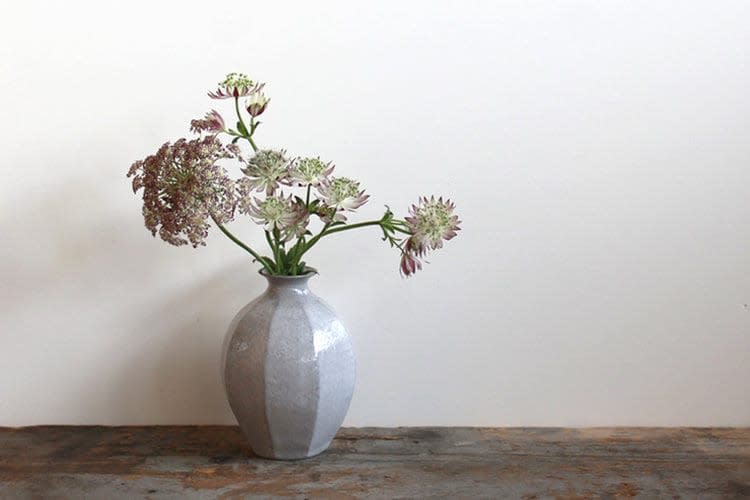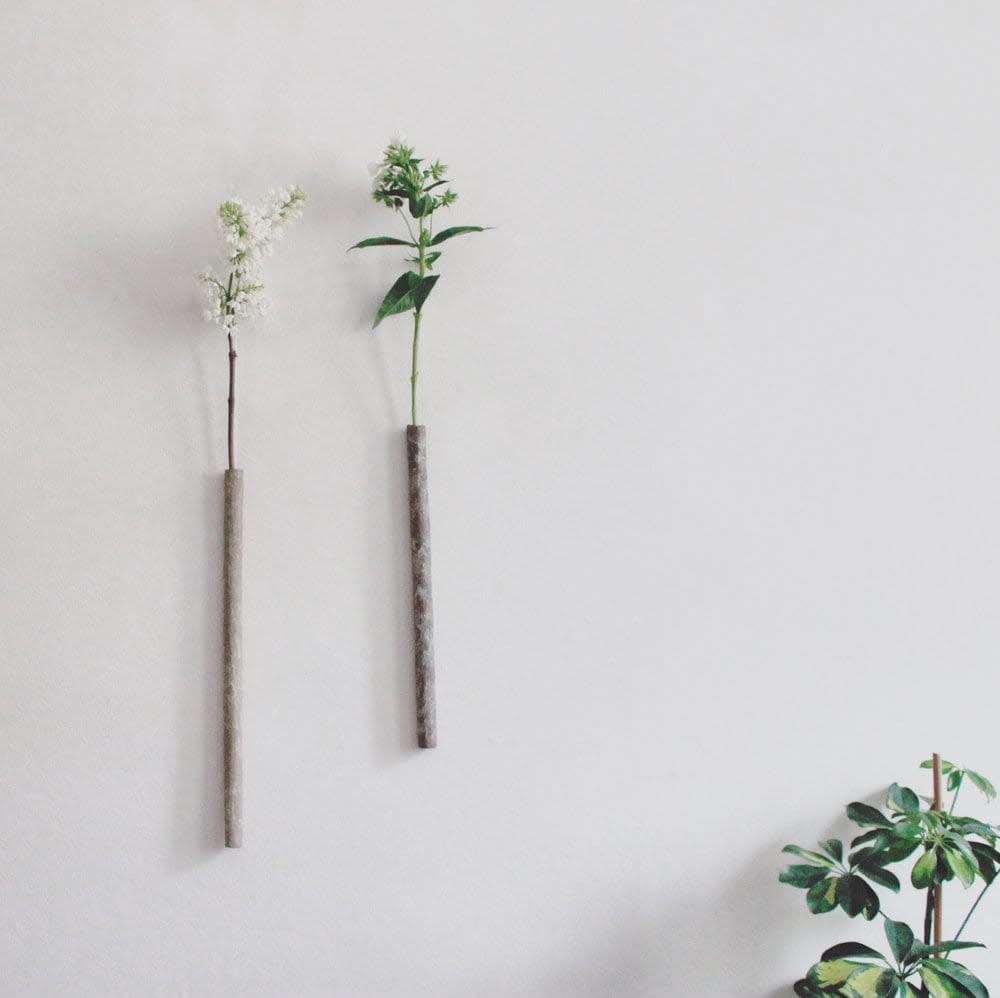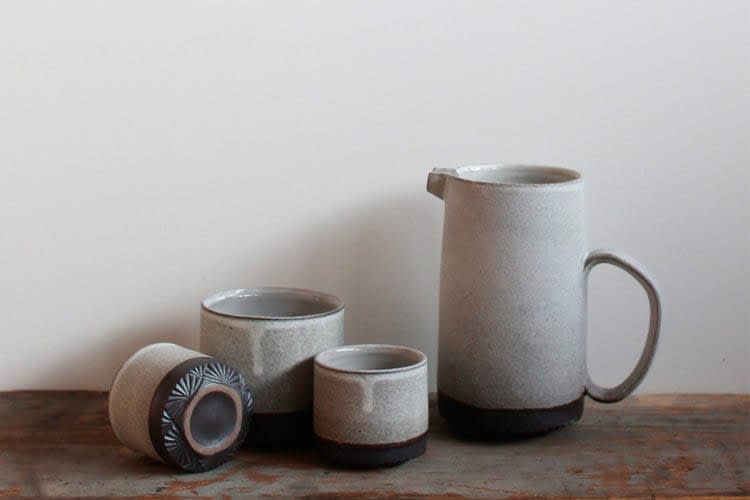-

Cavaliero Finn has been working with Japanese ceramicist Mizuyo Yamashita more or less since the company’s inception in 2004 and many of you will remember the delicate tiny, tiny butterfly and flora and fauna bowls we exhibited back then.
Since those days Mizuyo’s work has gone from strength to strength and recently she was commissioned to make a collection of exclusive pieces for the ‘Giacometti’ exhibition at the Tate Modern for the Tate Edit shop which ran alongside the major retrospective exhibition. In this interview we find out more about our ceramicist and what inspires her to create her work.In conversation with Mizuyo Yamashita

CF: How did you become a ceramicist?
MY: It was when I encountered Grayson Perry’s pots for the first time in the Saatchi Gallery. I was amazed to discover how a pot can carry political and social messages, and was also intrigued by the processes he uses to decorate it. Before coming to London I was collecting pretty pottery, but this revelation strongly inspired me to learn how potters make their pots.
Straight away, I enrolled into an adult education college and a started part-time pottery course. I just fell in love with working with clay. I was doing a lot of slab-building as my throwing was terrible back then! My career as a ceramicist started when my tutor in the college recommended me to join his Christmas craft fair. I suddenly got orders from shops and that’s when I started making pots to sell.
Dame Lucie Rie, ca.1964, photograph by Steffi Braun-Olsen
(image source: The Dowse Art Museum)CF: Are there any artists or ceramicists that particularly inspire you?
MY: I really admired Dame Lucie Rie, the way she continued to work with clay in such difficult times and also the exquisite balance of modernity, sophistication and playfulness in her work.
I have so many potters I love, especially in Japan! But the potters who inspired me to throw in particular were Rupert Spira and Gwyn Hanssen Pigott.
CF: How important is your culture in your work?
MY: My culture is very important whether I’d like to take it away or not. At the beginning of my career I wanted to make something different from the traditional Japanese pottery I’d grown up with. I worked in porcelain and made thin wobbly bowls with subtle textures and prints. However, even then, I was drawing techniques from Japanese craft.
Now I appreciate the skills and earthy aesthetics of the craft pottery and draw inspirations from a lot of crafts especially from my own culture.
CF: Describe your process of making work?
MY: I use many techniques, but I throw most of the work I create on the potter’s wheel and apply surface decorations. To make my Mentori vases I facet and carve the surface with sculpture tools. To make the Kiriko beakers I use wood carving chisels. I put a shiny glaze inside to make it water-proof and a matt glaze I developed. In my Kiriko series I love where metallic glaze and matt glaze turns into a beautiful shiny brown surface.
CF: How important is drawing to you and does it play a part in your work?
MY: I throw first without drawing most of the time. Throwing itself is already drawing in 3D. Then when I need to reconsider the shape, I draw in a sketchbook to analyze what went wrong with it. In my sketchbook I have a lot of profile sketches and display sketches. The profile sketch is helpful when I want to analyze the stages of throwing and the display drawing is when I need to know what to make for shows. I also have some sketches from when I have collaborated with artists, to communicate our ideas.
I have recently started using a lot more patterns in my work and have been doing a lot of pattern analysis in my sketch book. These are for the new techniques I have started exploring.
CF: Do you welcome mistakes or accidents in your work?
MY: I very much welcome it although it’s a real disappointment at first. I learn so much about how to handle the materials. I’m not at all a scientific potter, so I need to test a lot to achieve what I want. Sometimes a very happy accident happens in that process and I get inspiration for new work.
CF: Where do you get your inspiration and how do you come up with new work?
MY: It is a continuous exploration. Sometimes a certain technique/a new tool drives me to try different shapes and patterns and finding a new glaze that I get by accident makes me want to make a new shape that enhances that glaze. Sometimes when I’m learning about other crafts I’m thinking if I could apply their techniques or knowledge to my practice.
When I go back to Japan I visit potteries to learn about their rich culture. I go to the British Museum to see a variety of shapes and techniques. My favourite section has been always Proto-Corinthian and Minoan pottery for their elegant shapes.
I also go to The Victoria and Albert Museum to study their displays but also to read/see the books in their library.
CF: How has your work evolved since you started working in ceramics?
MY: I know it has evolved a lot but it’s difficult to say how. I think I have gained more knowledge and skills therefore I have more control on what I can do with the materials. My work made a big shift when I purchased my first potter’s wheel. I now throw most of the shapes on the wheel.
CF: You recently made work in response to the Giacometti exhibition at the Tate, how did you approach this and manage to respond to such an extensive exhibition?
MY: When I saw the list of works going into the exhibition, what caught my attention was the tactile quality of the work, the materials and volume. I think the museum recognised these aspects in my work, in the way I apply subtle textures and make small vessels. It seemed natural that I pursue these qualities in my response.
L’Homme au doigt (Man Pointing), Alberto Giacometti, Bronze, 1947
Image courtesy of the Tate
MY: To understand Giacometti’s work I researched his sources of inspiration: the Ancient Arts; Greek, Etruscan, Egyptian, etc. and a particular pot caught my eye. It was a Abydos wine jug from the early Bronze Age and it was very beautiful. I especially loved its profile line from the bottom to the neck. As Egypt was a huge inspiration for him, it made sense to pick up this object as a starting point for a small vessel collection.
I was also interested in his very unique, iconic sculpture. I wondered what might happen if I made a very thin and long vessel. That’s how I came up with the design for a single stem vase.
CF: Do you have any advice for anyone hoping to break into the ceramic industry?
MY: I found making is the rather easy part of my work. If you want to turn your passion into a business you have to do a lot more other things as well. In my case, my language barrier has hindered my ability to market my business a little, I shy away from selling my work. Luckily, I was picked by some amazing galleries, shops and an art agency and they have been helping me with this side of my business. Otherwise, you need to know what is special about your work and present it well and professionally. Nowadays, social media platforms, such as Instagram and twitter, are great tools to sell your business and if you have good images it’s easy to make a nice gallery of your work.
CF: Do you have a favourite piece from your series of work and do you have a favourite type of material to use?
MY: All finished products are my favorites but I enjoy some making methods more than the others. I enjoy making Kiriko beakers as carving the pattern with my sharp chisels is very satisfying. I love using the matt glaze I developed as it responds to the clay body really well.
I love mixing grains granites as it gives a lovely earthy texture.
CF: What are your thoughts on the current rise in interest in all things ceramics, and what do you think has caused this resurgence of interest?
MY: I welcome this trend as people take me more seriously, whereas previously, some people would assume pottery was an old fashioned hobby. It is great that I can now meet people who can talk so much about ceramics or their experience with short courses. But for me, any promotion of the ceramic industry has to one where originality, skill or expertise are part of the mix.
I think Grayson Perry has definitely played a big part in the current resurgence of interest. About seven years ago I started getting requests from artists for help with the technical side of things. So there was something starting to happen back then among the artist community.
Also it’s possible that the food industry as played a role. People are much more interested in food these days and there are a plethora of beautiful cookbooks on the market all featuring wonderfully stylized images using vintage plates and hand-made ones.
And of course, The Great Pottery Throw down TV programme has definitely intrigued people more I think.
CF: Do you have any hopes or aspirations for the future?
MY: Yes I only have hopes! Being a ceramicist is a life time occupation and at the moment I am still experimenting and learning. My skills and knowledge in comparison to those of my ceramic heroes are very limited. I am hoping to learn more and hopefully these will come together to make something I’ve never imagined!
All images of Mizuyo’s work used in this interview are courtesy of Mizuyo Yamashita
Buy Mizuuyo's ceramics here